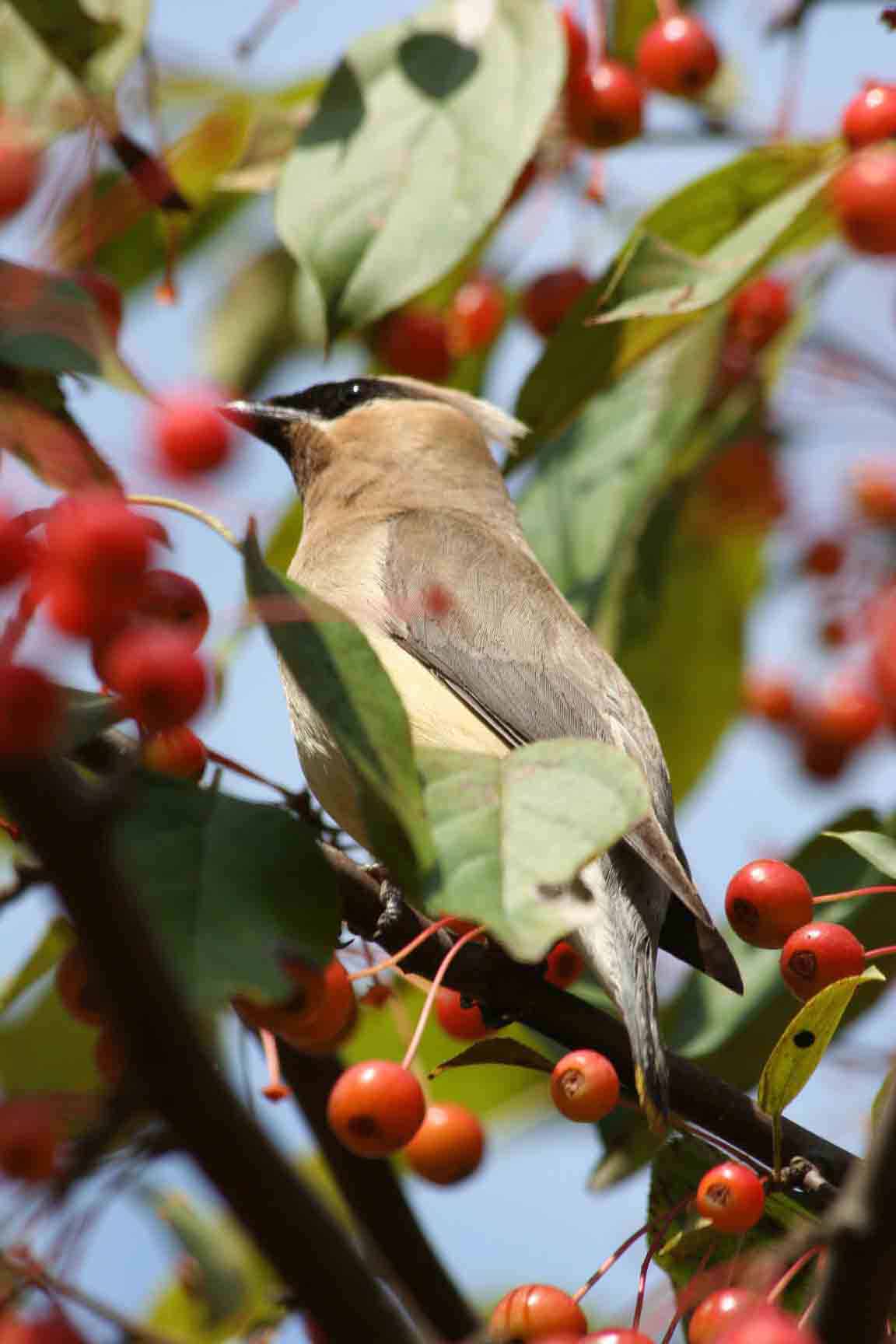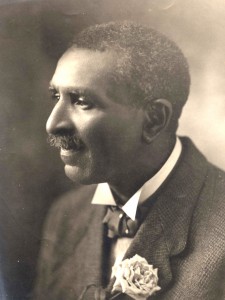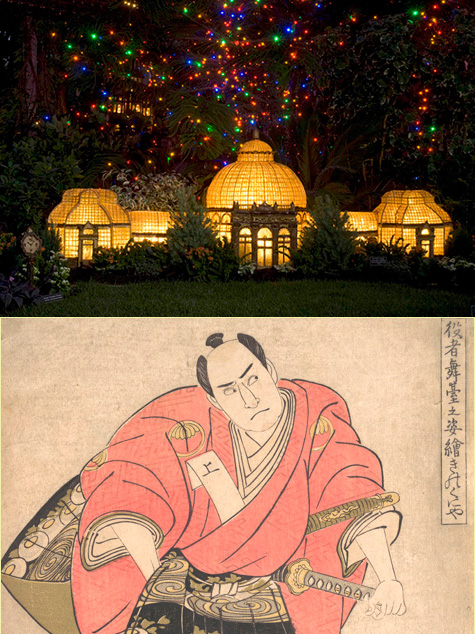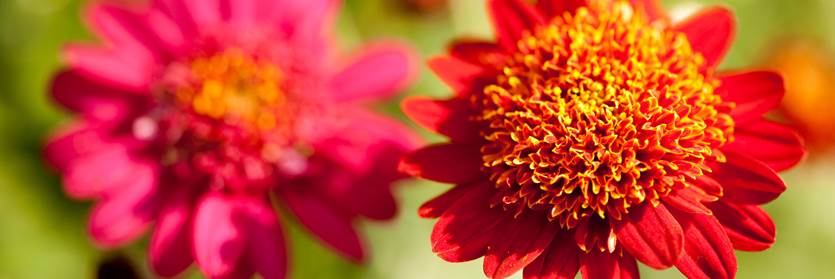Inside The New York Botanical Garden
Plant Talk
Posted in Programs and Events, Wildlife on January 23 2009, by Plant Talk
Colors of Cardinals, Ducks, and More Dazzle Against the Snow
 |
Debbie Becker leads a free bird walk at the Garden every Saturday from 11 a.m. to 12:30 p.m., beginning at the Reflecting Pool in the Leon Levy Visitor Center.
|
 Winter birding at NYBG is always a delight. Once the deciduous trees have shed their leaves all is visible. Streaks of winter sun embrace the Forest and ignite the trees in deep silhouettes and wonderful brown hues. There is something about the frosty sunlight that brings out the vibrant color of the birds. The red-bellied woodpecker’s cap glows in red amber as the bird climbs a tree barking for attention. The northern cardinals are so brilliant in the sun as they sit on the bare branches—their red and orange feathers a sharp contrast to the white snow and brown tree stems. Even the blue jays’ cerulean feathers glow like a Matisse as the birds peck around the snow for morsels to eat.
Winter birding at NYBG is always a delight. Once the deciduous trees have shed their leaves all is visible. Streaks of winter sun embrace the Forest and ignite the trees in deep silhouettes and wonderful brown hues. There is something about the frosty sunlight that brings out the vibrant color of the birds. The red-bellied woodpecker’s cap glows in red amber as the bird climbs a tree barking for attention. The northern cardinals are so brilliant in the sun as they sit on the bare branches—their red and orange feathers a sharp contrast to the white snow and brown tree stems. Even the blue jays’ cerulean feathers glow like a Matisse as the birds peck around the snow for morsels to eat.
Perhaps the most spectacular sight in winter are the ducks on the Bronx River. White-and-crimson-orange hooded mergansers bob in the gentle flow of the river, their white heads parallel to the white snow on the river’s banks. The female with her spiked burgundy head is a sharp contrast and a delight to watch as she dives under the water searching for food.
Cedar waxwings dressed in yellow, red, and beige with a black mask pop yellow, red, and purple crabapples off the branches and into their beaks, making the perfect palette of color come alive.
Tiny black, gray, and white chickadees dance on the sweet gums’ brown sticky seed balls, pecking inside for the last of the autumn treat. Flocks of white-throated sparrows dance in the oak leaves on the ground, hopping back and forth in efforts to dislodge a hibernating spider from its berth. It is a well-choreographed movement that can be played in one’s mind to Beethoven’s Fifth.
One of the great joys of winter birding is hand-feeding chickadees. It is at this time of year that the chickadees, tufted titmice, and occasionally a cardinal are apt to land in one’s outstretched palm if you offer black oil sunflower seeds or roasted peanuts. The birds need the food for nourishment and to keep warm during the cold days of winter. Chickadee use a technique of shivering to keep their body temperatures high enough to survive and the protein from the sunflower and peanuts give them the fuel to perform the shivering technique.
Red-tailed hawks, Cooper’s hawks, and sharp-shinned hawks are also quite visible as they quietly sit on a branch waiting to pounce on their next victim.
In the quietness of the snow, in the shadows of the winter sun, the birds often reflect the silence of the season with a warm melody of song.
Check out Saturday’s programming
Check out Sunday’s programming
Posted in Learning Experiences, Programs and Events on January 22 2009, by Plant Talk
 |
Jeff Downing is Vice President for Education. |
In the past year the Garden has developed a number of training programs in conjunction with the New York City Parks Department to help increase the pool of capable job candidates. First, the Garden’s Horticulture and Education divisions collaborated on an urban tree care course to train a new generation of Parks foresters. Next, the Garden designed a special course for the Parks Opportunity Program, which trains local career-seekers in the fundamental skills necessary for the numerous vacant horticulture positions at the Parks Department and elsewhere. Recently, the Garden devised yet another program, one that is training 30 competitively selected 18–24-year-olds to help facilitate Mayor Bloomberg’s Million Trees Initiative.
The common thread in all of these wonderful initiatives is opportunity: Even in uncertain economic times the field of horticulture offers a wealth of career prospects for those willing to learn the required professional skills. And the opportunities are not just in New York City but throughout the region and beyond.
It has hit me that we at the Garden need to do a better job of spreading the word about the multitude of horticulture-related career tracks—from propagation and plant care to arboriculture, landscape and garden design, and horticultural therapy (using plants in therapeutic settings). So in the fall, the Garden’s Continuing Education program organized a couple of free Career Information Sessions and asked recent Continuing Ed certificate recipients to come and discuss their experience in the Garden’s education program and how it helped them get started in a new career.
Landscape Design graduate Robert Welsch talked about his burgeoning business, Westover Landscape Design, in Westchester. Sheri Forster explained how the Horticulture certificate she earned just this past spring allowed her to jumpstart a thriving business of her own, The Scottish Gardener, in Manhattan. Other former students and program instructors rounded out the evenings, giving their own unscripted and unedited appraisals of the business of horticulture and the Garden’s education programs. The give and take was free flowing, and those who came asked all the questions I would want to know if I were thinking about a new career such as:
- If I invest the time and money to learn these skills, will there really be career opportunities available when I complete a certificate?
- Do the Garden’s certificate programs provide all the knowledge and skills needed to really do this?
- Do I have to commit to a whole program before I really know whether this is for me, or can I start with a short introductory class and see how it goes?
If you missed these informative sessions but are interested in learning the answers to these questions (and any others) about careers in horticulture and landscape design, we’ve arranged to do the whole thing again, with a new group of students and instructors. So mark your calendar for Wednesday, January 28, from 6 to 8 p.m. and pre-register to attend our free Career Information Session.
I hope to see you there!
Posted in Exhibitions, Programs and Events, Science on January 21 2009, by Plant Talk
 |
Nick Leshi is Associate Director of Public Relations and Electronic Media. |
 When I talk about The New York Botanical Garden, one phrase I tend to repeat over and over is: “No matter what the weather is like outside, there is always something to see and do here, both indoors and out.” In addition to the beauty of the Garden’s grounds and living collections in every season, there are also great indoor attractions. One of my absolute favorites is located on the fourth floor of the Library building—the permanent exhibition Plants and Fungi: Ten Current Research Stories.
When I talk about The New York Botanical Garden, one phrase I tend to repeat over and over is: “No matter what the weather is like outside, there is always something to see and do here, both indoors and out.” In addition to the beauty of the Garden’s grounds and living collections in every season, there are also great indoor attractions. One of my absolute favorites is located on the fourth floor of the Library building—the permanent exhibition Plants and Fungi: Ten Current Research Stories.
The exhibition, housed in the grand Britton Science Rotunda and Gallery, allows visitors to explore the important research being conducted by Botanical Garden scientists here in the Bronx and around the world. Massive mural images of the Garden’s founders, Nathaniel Lord Britton and Elizabeth Knight Britton, overlook a map showing the corners of the world where our scientists have traveled for field research to solve some the mysteries of nature and to better understand the role of plants and fungi in our lives, part of the Garden’s overall mission as an advocate for the plant kingdom.
 The rotunda features multiple displays illustrating the “William C. Steere Tradition,” with information on mosses, lichen, and three panels on mushrooms and berries. It educates the public on the legacy and influence of the man for whom the adjacent William and Lynda Steere Herbarium is named and where over 7 million plant and fungi specimens are archived. Computer terminals in the Gallery allow visitors to access the online specimen catalog from the C.V. Starr Virtual Herbarium.
The rotunda features multiple displays illustrating the “William C. Steere Tradition,” with information on mosses, lichen, and three panels on mushrooms and berries. It educates the public on the legacy and influence of the man for whom the adjacent William and Lynda Steere Herbarium is named and where over 7 million plant and fungi specimens are archived. Computer terminals in the Gallery allow visitors to access the online specimen catalog from the C.V. Starr Virtual Herbarium.
Other computer stations in the exhibition provide audio-video presentations explaining Garden scientists’ research on rice, cycads, brazil nuts, squashes, ferns, and vanilla orchids. Visitors young and old can see how modern tools such as DNA fingerprinting as well as classic techniques of plant exploration are used, and how scientists are studying vital topics like genetic diversity in rice and a nerve toxin in cycads that may provide insight into neurological diseases.
You can meet some of the scientists in person and hear them discuss their research as part of the 2009 Gallery Talks series Around the World with Garden Scientists in the Britton Science Rotunda and Gallery. Robbin Moran, Ph.D., kicks off the series this Saturday, January 24, at 1 p.m. with his presentation “The Fascinating World of Ferns” and provides a behind-the-scenes tour of the Herbarium.
Posted in Exhibitions, Programs and Events on January 16 2009, by Plant Talk
The Legacy of George Washington Carver
 |
Dachell McSween is Publicity Coordinator at The New York Botanical Garden. |

One of my favorite times in the Garden is in January. Yes, I know it is cold outside and it gets dark early, but I look forward to seeing The Life and Work of George Washington Carver exhibit and program in the Everett Children’s Adventure Garden. This fun and informative exhibit looks at the life of George Washington Carver, the renowned plant scientist who created hundreds of uses for peanuts, soybeans, and sweet potatoes.
Dr. Carver was born to slave parents in Diamond Grove, Missouri, in 1864. As a child, he developed an early interest in plants. In fact, he became known as the “plant doctor” for helping neighbors and friends with ailing plants. He learned to read, write, and spell at home, because there were no schools for blacks in his hometown. In 1891 he became the first black person to enroll at Iowa State College of Agriculture and Mechanic Arts, known today as Iowa State University. After completing his Bachelor’s Degree in 1894, Dr. Carver’s professors encouraged him to stay on as a graduate student. He became known for his excellence in plant breeding and was appointed to Iowa State’s faculty, becoming its first black faculty member.
The exhibit in the Children’s Adventure Garden makes me appreciate all of Dr. Carver’s vast accomplishments. I enjoy seeing children transform into “plant scientists” by putting on lab coats and picking up a magnifying glass to diagnose and remedy sick plants, just like Dr. Carver did as a child. The children also create a personal science timeline, plant a soybean to take home, and enjoy stepping into the interactive yellow replica of Dr. Carver’s Jesup wagon, which he used as a traveling school to help spread his agricultural knowledge to farmers and homemakers. The wagon was named after Morris K. Jesup, a New York financier and philanthropist.
As we look forward to celebrating Dr. Martin Luther King Jr. Day and the inauguration of America’s first black president, it is inspiring to see children get excited about this remarkable program that encourages them not only to learn about plant science, but also to dream big and impact the world, just like Dr. Carver did.
Check out Saturday’s programming
Check out Sunday’s programming
Posted in Gardens and Collections on January 14 2009, by Plant Talk
 Carol Capobianco is Editorial Content Manager at The New York Botanical Garden.
Carol Capobianco is Editorial Content Manager at The New York Botanical Garden.
 What a glorious sight to come upon: the beautiful orchids displayed in the Orchid Rotunda on the second floor of the Library Building. Brilliant hues, fantastic shapes, lovely arrangements.
What a glorious sight to come upon: the beautiful orchids displayed in the Orchid Rotunda on the second floor of the Library Building. Brilliant hues, fantastic shapes, lovely arrangements.
The continuous show of these colorful gems that brighten any gloomy day had been on hiatus since mid-April of 2008, when the display case was installed with the maquettes and found objects of sculptor Henry Moore in conjunction with the Moore in America exhibition across the Garden grounds.
Though Moore in America has been extended to March 15, the artist’s scale models, tools, and collection of bones, rocks, and other natural bits and pieces have been removed to make room, once again, for the spectacular, delicate orchids. And just in time. These magical flowers whet our appetite daily for the upcoming annual Orchid Show, which opens February 28 in the Enid A. Haupt Conservatory.
In the meantime, on a cold, gray day—or any day—come marvel at this display, which is refreshed twice a week. It is sure to lift your spirits.
Posted in Learning Experiences on January 13 2009, by Plant Talk
 |
Joan McGillicuddy, a double certificate graduate of the Continuing Education program, now has her own design company, The Surrogate Gardener, on Long Island.
|
It’s a new year, so it is time for me to see which lectures in the American Gardening Lecture Series I might be able to schedule. I started attending NYBG’s Lecture Series years ago as part of a personal goal to expand my plant knowledge. I went on to complete two certificates, one in Horticulture and one in Landscape Design, through the Botanical Garden’s Continuing Education program and now have a career as a landscape designer. Yet, every year I still make time to attend several of the lectures in this series. I am an unrepentant plantaholic. In spite of what some garden design books say about having a plan, several past presenters have admitted to the same compulsions, so I merrily continue to experiment with new plants.
It doesn’t matter how many garden books or magazines I read, there is nothing like the immediacy of listening in person to experts— landscape architects and designers, plant hybridizers and nurserymen, authors and garden curators—impart their knowledge. The Lecture Series always offers a diverse mix of subjects and speakers, and I always leave inspired to try new plant introductions, new combinations of tried and true plants, or new horticultural practices. Then there is the added treat of reviewing the books laid out like jewels on the tables in the Gallery outside the Lecture Hall, which only tempts me to go to the Shop to review the entire book collection.
The Lecture Series is scheduled at a perfect time of the year, when my garden is quiet and nursery catalogs are arriving and I have time to track down the plants I am inspired to try. After the lectures and a bowl of soup at the Cafe, I stroll through NYBG’s gardens and see which plants are greeting the new year, since it is warmer here than at my home on Long Island. My favorite plant is the large Hamamelis on the outer drive that holds its yellow flowers through the snow. It always signals to me that spring is around the corner. The Ladies’ Border, which runs along the south side of the Conservatory, always has something new in bloom each month of the series, whether it is January, February, or March. It might be Mahonia, Edgeworthia, Hamamelis, Helleborus, or Camellia. This year it will be a treat to watch the emergence of the display beds across from the Cafe entrance, known as Seasonal Walk, that were created by the well-known designers Piet Oudolf and Jacqueline van der Kloet. I happened to see the beds being installed this past fall, and they look to be an intriguing mix of bulbs, perennials, and grasses.
At a time when much of the world news is gloomy, it is nice to have all this to look forward to.
Posted in Holiday Train Show, Kiku, Moore in America on January 9 2009, by Plant Talk
Holiday Train Show and Japanese Art Exhibit Take a Bow
 Another exhibition season ends this weekend with the closing of the ever-popular Holiday Train Show as well as the stunning exhibition The Chrysanthemum in Japanese Art.
Another exhibition season ends this weekend with the closing of the ever-popular Holiday Train Show as well as the stunning exhibition The Chrysanthemum in Japanese Art.
In fact, you have the value-added opportunity to see four remarkable exhibitions for the price of one All-Garden Pass admission ticket. In addition to these two shows, you can also see Moore in America, which has been extended to March 15, and The Heirloom Tomato: An Exhibition of Photographs by Victor Schrager.
What a deal—especially in these financially challenging times.
Posted in Exhibitions, Moore in America, NYBG in the News on January 8 2009, by Plant Talk
 |
Nick Leshi is Associate Director of Public Relations and Electronic Media. |
Visitors of all ages have marveled at the sight of the monumental sculpture throughout the grounds of The New York Botanical Garden, where these works of art have stood sentinel since last spring. Moore in America, the largest exhibition of Henry Moore’s art ever displayed in a single venue in the United States, continues to attract praise from audiences and journalists alike, including Time magazine’s art critic Richard Lacayo, who named it one of the Top 10 Museum Exhibits of 2008.
Photographers, in particular, have been drawn to Moore’s captivating forms situated within the Garden’s historic landscape. In partnership with the International Center of Photography, the Botanical Garden hosted a photography contest in celebration of the landmark exhibition. The contest sparked many beautiful submissions, from which four monthly finalists were selected. From those four a grand prize was awarded, to Jimin Kim of Manhattan for his portrait of Large Reclining Figure. His winning image appeared in an advertisement for Moore in America in the December 4–10 issue of Time Out New York.
Runners-up included Julie Salles of Yonkers, Ken Schwarzof Lexington, Massachusetts, and Debra Allen of Pelham Manor. Their images, plus countless others submitted by garden- and art-loving shutterbugs during the months of the competition, showed how the sculpture could look fresh from different angles and with different lighting throughout the day and during the changing seasons, proving Moore’s desire to have viewers approach—and even touch—his artwork from different perspectives.
If you haven’t seen the exhibition yet, now is your chance. Moore in America is being extended through March 15. Even if you’ve seen it in spring, summer, or fall, now is your opportunity to see it in winter. Bring your camera and snap some pics for yourself while you’re at it!
Posted in Programs and Events on January 7 2009, by Plant Talk
 |
Samantha Buck is an Interpretation Intern for Public Education. |
 On my second day as an intern with The New York Botanical Garden, I had the esteemed pleasure of meeting Sir Topham Hatt and Thomas the Tank Engine™ from the Island of Sodor (both of whom were much larger than I remembered from watching the television show as a child). The excitement was palpable as a growing number of fans arrived in the Arthur and Janet Ross Lecture Hall, the majority of whom toted small children anxious for the experience.
On my second day as an intern with The New York Botanical Garden, I had the esteemed pleasure of meeting Sir Topham Hatt and Thomas the Tank Engine™ from the Island of Sodor (both of whom were much larger than I remembered from watching the television show as a child). The excitement was palpable as a growing number of fans arrived in the Arthur and Janet Ross Lecture Hall, the majority of whom toted small children anxious for the experience.
I carefully folded the gray and white paper conductor’s hat that was presented to me, pulled the elastic around my head, and was ready for my adventure! As I was greeted by the silently enthusiastic Sir Topham Hatt, visitors settled in to watch an episode or two of Thomas & Friends, who came to life on the big screen. Following the film, some in the audience went forward to meet Sir Topham Hatt. It was refreshing to see the youngsters interacting with him so animatedly.
I got the royal treatment: becoming an honorary engineer so I could “help Thomas and his friends out if they were ever in trouble.” Younger “engineers” were also presented with coloring pages of Thomas, James, Percy, and Gordon, along with a box of crayons and stickers depicting other favorites. And of course, no visit to this event would be complete without a photo with Thomas the Tank Engine™ himself, happy and eager as ever to meet each and every one of his fans.
Come visit Thomas the Tank Engine™—he’s here through January 11.
Posted in Exhibitions, Holiday Train Show on January 6 2009, by Plant Talk
 |
Gingerbread Adventures in the Everett Children’s Adventure Garden includes a display of detailed and fragrant gingerbread creations by renowned pastry chefs in and around New York. Here Leslie Randazzo, co-owner with her husband, Mark Randazzo, of Mark Joseph Cakes, describes how they conceptualized and executed their design.
|
Although Mark and I had never worked with gingerbread before, we were so enthusiastic about making our gingerbread debut in The New York Botanical Garden’s annual holiday exhibit. Yes, Mark is a pastry chef, but he specializes in custom cakes, so this was quite different.
This year’s theme, “Gingerbread People at Work and at Play,” left us wondering “What do gingerbread people do?” I called my nephew, Harry, whose immediate response was, “the same things we do.” Aha! Brilliant! With our target audience being kids, we thought about careers revered by children. It was my sister who suggested firemen. Then we were on a roll. Mark and I share a love for New York City’s pre-war architecture, so there was no question that we’d model our main structure after an old FDNY house. Through research, Mark found one in Manhattan on Lafayette Street that is stunning.
Our next order of business was a crash course in gingerbread structures, namely, keeping them up. For this, Mark made an icing that was similar in consistency to cement. We cut the gingerbread dough into the dimensions that were already carefully calculated. These large pieces make up the main structure. Then we cut gingerbread dough into equally sized rectangles. These were used as a second layer, to achieve the stones the building is made of. Laying the “stones” was extremely time consuming, because the firehouse had so many dimensions and different shapes to work around and each “stone” had to be trimmed to fit precisely in the appropriate space. The windows were made using a sculptor’s molding material that we melted and poured into the gingerbread’s square openings. As it dried, it solidified beautifully. To light the inside, we used LED Christmas lights that we clipped short. For the roof, we thought the perfect candy would be bite-sized black licorice that we would line up to look like shingles. Unfortunately, after placing on more than half of the licorice we discovered that the oily coating used to keep the pieces from sticking together in the package were also keeping them from sticking to the icing. The solution was Nilla® wafers. We were concerned that they wouldn’t cut easily with a knife, but they worked quite well.
Once the main structure was completed, we began adding the details. Red Twizzlers® were used for each window frame, and icing was piped on to create the appearance of snow. The fire truck was decorated using a sugar dough called “gum paste.” Then we designed the wintry fun that one notices when examining the display closely such as the snowball fight and the boy making a snow angel as the firemen look on.
This entire experience was so rewarding; it felt like a tremendous accomplishment after a total of 70 hours of labor. It was great fun and well worth the effort.

 Winter birding at NYBG is always a delight. Once the deciduous trees have shed their leaves all is visible. Streaks of winter sun embrace the Forest and ignite the trees in deep silhouettes and wonderful brown hues. There is something about the frosty sunlight that brings out the vibrant color of the birds. The red-bellied woodpecker’s cap glows in red amber as the bird climbs a tree barking for attention. The northern cardinals are so brilliant in the sun as they sit on the bare branches—their red and orange feathers a sharp contrast to the white snow and brown tree stems. Even the blue jays’ cerulean feathers glow like a Matisse as the birds peck around the snow for morsels to eat.
Winter birding at NYBG is always a delight. Once the deciduous trees have shed their leaves all is visible. Streaks of winter sun embrace the Forest and ignite the trees in deep silhouettes and wonderful brown hues. There is something about the frosty sunlight that brings out the vibrant color of the birds. The red-bellied woodpecker’s cap glows in red amber as the bird climbs a tree barking for attention. The northern cardinals are so brilliant in the sun as they sit on the bare branches—their red and orange feathers a sharp contrast to the white snow and brown tree stems. Even the blue jays’ cerulean feathers glow like a Matisse as the birds peck around the snow for morsels to eat.









 Another exhibition season ends this weekend with the closing of the ever-popular
Another exhibition season ends this weekend with the closing of the ever-popular 
 On my second day as an intern with The New York Botanical Garden, I had the esteemed pleasure of meeting Sir Topham Hatt and Thomas the Tank Engine™ from the Island of Sodor (both of whom were much larger than I remembered from watching the television show as a child). The excitement was palpable as a growing number of fans arrived in the Arthur and Janet Ross Lecture Hall, the majority of whom toted small children anxious for the experience.
On my second day as an intern with The New York Botanical Garden, I had the esteemed pleasure of meeting Sir Topham Hatt and Thomas the Tank Engine™ from the Island of Sodor (both of whom were much larger than I remembered from watching the television show as a child). The excitement was palpable as a growing number of fans arrived in the Arthur and Janet Ross Lecture Hall, the majority of whom toted small children anxious for the experience.